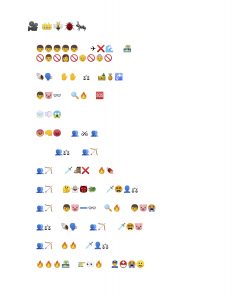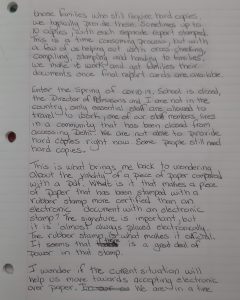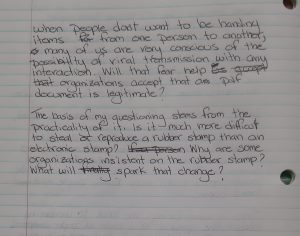Below is a direct transcript of a story about my family’s trip to Athens, Greece. This story was unscripted and dictated using the Text Edit on my MacBook Air laptop.
_________________________________________________________________
Hello this is a story about my family trip to Athens Greece in November 2018 in the spring of 2018 my husband and I realised that barbie was going to coincide with the Athens marathon in November. So we figured out how to register for the marathon and signed out and then booked our trip to Greece we stayed at an in error B&B in Athens and it was so beautiful it was so nice to explore the city and just spend a few days we spent a week there and meeting up to the marathon and were able to explore our friends and enemies
We love their restaurants and the easy-going attitude in Athens and enjoyed exploring on the Internet history states my husband is our history teacher and has type into history as well so was really excited about going to the personal learning and seeing other historical sites we took a road trip Wendy 255 and it that was another amazing experience. Underweighted off I would discover that there is a ski town just outside of Athens which we didn’t realise there is skiing in Athens that was just another interesting discovery and I
At the end of the week we were had to prepare for a air sign we went and picked up a risk it and then a few days before the mirror fine we drove from Athens to have fun along the roots of the run and spent some time in the town of marathon and I’m now on the ocean. During the visit and drive to and from mirror finally realised just how silly this route was going to be we had both run multiple Netherlands before but this was definitely going to be the biggest climb every and also the biggest coward I think the had about 20,000 pieces p so it was very exciting and huge but is really very difficult we realised. On the day of the mirror sign we need to combust out to the town of Maryland where the start line is very early in the morning and waiting with thousands of other people for the stack to begin the very exciting energy end there and very interesting place to be there instead of advancing the only people warming up and I’m just regular people getting ready to go in their throwaway sweaters to stay worm and some people were in garbage bags is just a fun interesting atmosphere.
The run itself proved to be quite tricky as expected the hills were extremely challenging and by the time I shuts the last 10 km my legs were just warrant out and it was a very slow finish for me to get to the end of the race. But the finish coming into the Olympics stadium and is seeing all those people in running with with so many people to the whole race was so exciting and invigorating and such an amazing experience so although it was difficult and painful and made for a very uncomfortable drive to the airport and flight back to Delhi it was such an amazing experience and when there we will never forget. It was well worth the pain and the trouble.
_________________________________________________________________
Analysis of the text:
How does the text deviate from conventions of written English?
The first obvious deviation from conventional written English is the lack of punctuation and paragraphs. Written English typically provides us with visual cues to help us know when to pause and separate thoughts. At a few points in the story, when I was waiting for the text to catch up, I said “period” or “new line”, but for the most part, I let the dictation continue without trying to punctuate. Another deviation from written English is the movement and progression of the story. With written English, we can consider the flow and adjust it into paragraphs that have one theme or idea. With an unscripted story, we sometimes move back and forth through ideas as they are remembered and therefore don’t always have a clear flow of ideas.
What is “wrong” in the text? What is “right”? What are the most common “mistakes” in the text and why do you consider them “mistakes”?
There are a number of things that could be considered wrong with the text. As already discussed, there are no paragraphs or punctuation, which can make it challenging to follow. There are also several words that were missed and a few sentences that were not captured by the software. Most of the mistakes are simply due to the dictation selecting a word or words that differ from what was spoken. Some of the errors are somewhat decipherable from my memory of what I said: “Fall break” became “barbie”, “taught ancient” became “type into”, “race kit” was spelled out as “risk it.” For some reason, the word “marathon” was mistaken several times for different words, including “Netherlands”, “mirror fine”, “mirror finally”, and “Maryland.” I suspect it must take some practice to speak clearly and slowly enough to have the software pick up on all of the words. For some of the errors, I can’t even remember what was said, for example it says “explore our friends and enemies”; I’m not sure what I said, but it wasn’t “friends” or “enemies”.
The general idea of the story is there, and one could likely follow the story and generally know what was being shared. The majority of the words are correct, and the dictation likely provides enough information to be understood, particularly if the reader was aware that the story had been dictated. This knowledge might lead a reader to try to “hear” the story in their mind as if it was being spoken.
What if you had “scripted” the story? What difference might that have made?
If the story had been scripted, the dictated text would likely be more accurate and easier to read. The dictation could have included punctuation and paragraphs, and this would have facilitated pauses in speech that would enable the typing to keep up with the speech, there were a few times during the dictation that the typing seemed to get behind and ended up cutting off part of a sentence. Having a script would also help with the flow of ideas.
In what ways does oral storytelling differ from written storytelling?
Oral storytelling can allow for a more dramatic and fluid re-telling of a story, with some changes each time it is told. The tone and vocabulary can adjust depending upon the audience, are they young? Do they have any special knowledge of the context? Have they already heard the story? Descriptions can be added or removed depending upon these and other factors. An oral story can be a living entity, while the written word is static. Oral storytelling has the risk of leaving details out, but also affords the opportunity to re-iterate ideas or provide information later that had been left out. A written story can be carefully crafted and edited to ensure clear ideas and smooth transitions. Although an oral story can be rehearsed and crafted, it will still always be a living story and take on a new life depending upon the person who is telling it. The written story, especially if read to oneself, is dependent upon the reader for interpretation and provides no opportunity for clarification or re-iteration unless it is anticipated and worked into the text.





 The everyday items represented here are my laptop and sunglasses (which I have still been using daily). Daily items that are missing from the bag (because they’re still in my apartment in Delhi) are my school ID and my travel mug. Since I live on campus at school, I don’t have any daily commute, which is represented in the simplicity of my daily items. I don’t need any keys, there is nothing that indicates running, tennis, volleyball, ultimate frisbee, or other pleasures that fill my time, since I can always just run home to change and pick up needed items.
The everyday items represented here are my laptop and sunglasses (which I have still been using daily). Daily items that are missing from the bag (because they’re still in my apartment in Delhi) are my school ID and my travel mug. Since I live on campus at school, I don’t have any daily commute, which is represented in the simplicity of my daily items. I don’t need any keys, there is nothing that indicates running, tennis, volleyball, ultimate frisbee, or other pleasures that fill my time, since I can always just run home to change and pick up needed items.